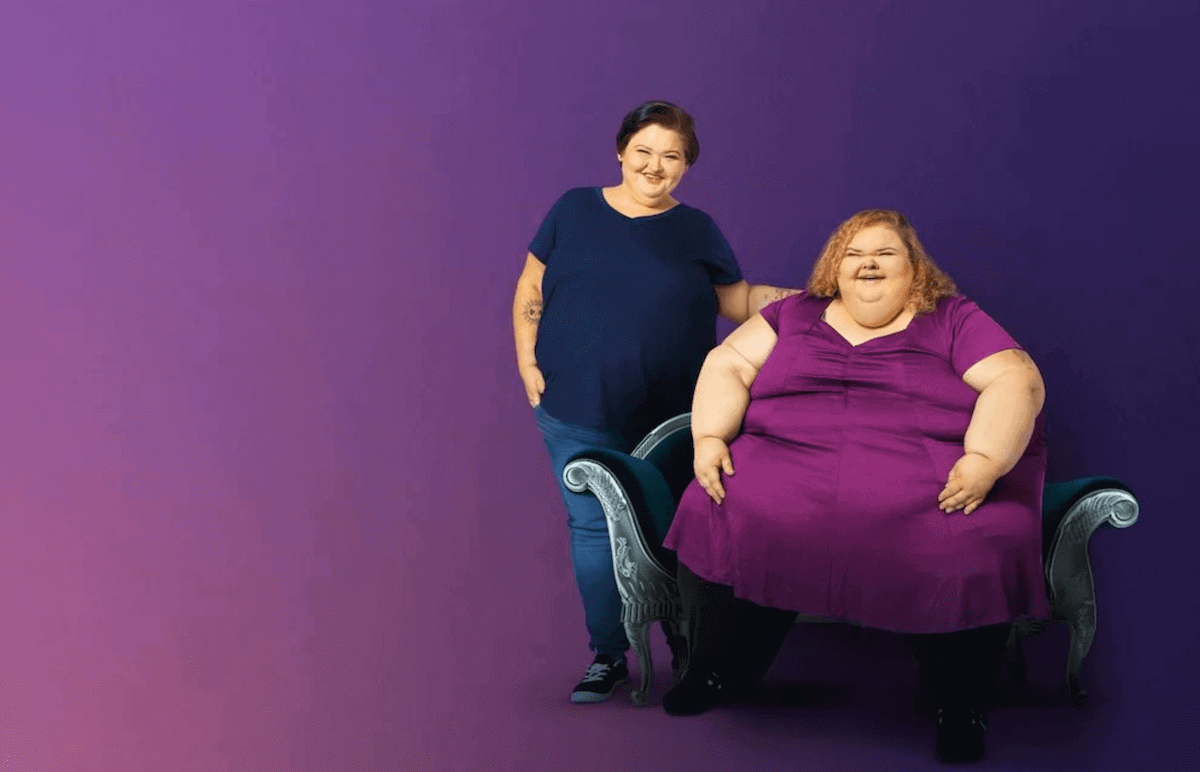1000 Lb Sisters Sodie - A Closer Look At The Number 1000
You might hear the number one thousand and think of many things, perhaps even a popular television program featuring a family's personal health journey. That number, one thousand, seems to pop up in all sorts of unexpected spots, doesn't it? It's not just a big number for counting; it actually holds a lot of different meanings and appears in quite a few everyday situations.
It's almost as if this particular figure has a way of showing up when we least expect it, from how we measure liquids to the way we talk about money in reports. We see it in the way numbers are put together, and even in some rather complex math problems. It's a pretty common figure, you know, whether we are looking at something very large or just a simple calculation.
So, we are going to take a closer look at this number, one thousand, and see how it shows up in various contexts, from how we count things to how we measure different items. It's interesting, really, how one number can have so many different uses and appearances in our daily lives, and in some more technical areas too.
Table of Contents
- The Building Blocks of 1000 - A Look for the 1000 lb Enthusiast
- What Makes a Number Like 1000 So Significant for Sisters?
- Understanding Large Figures - Is 1000 Just a Big Number, Sodie?
- How Does 1000 Show Up in Everyday Measuring, Sodie?
- 1000 in Financial Documents - A View for the 1000 lb Sisters
- Can We Break Down 1000 in Different Ways for Sisters?
- The Presence of 1000 in Digital and Learning Spaces - A Sodie Special
- Where Else Do We Find 1000, My Sisters?
The Building Blocks of 1000 - A Look for the 1000 lb Enthusiast
When we think about numbers, especially those that end in zeros, it's pretty clear that certain smaller numbers play a big part in their creation. For example, the number one thousand, or 1000, really depends on the numbers two and five to get those nice round endings. You see, when you multiply twos and fives together, you start building up those zeros at the end of a number. It's actually quite neat how that works, you know, like a secret code for digits.
And speaking of numbers that show up often, there are, apparently, a whole lot of even numbers out there. They are everywhere, really, making up half of all the counting numbers we use. This is just a basic idea, but it's pretty fundamental to how numbers behave. So, when we talk about big numbers like one thousand, it's good to remember these simple components.
You might recall that twenty-five multiplied by four makes one hundred, which, as you can tell, gives us two zeros at the end. That's a good example of how specific pairings of numbers can create those round figures we often see. It's a bit like a recipe, where certain ingredients give you a specific outcome. This particular combination is just one way to get to a number with a nice, clean finish.
Then, if you take that idea a step further, one hundred twenty-five times eight gives you exactly one thousand. This is another one of those neat tricks numbers play, where certain multiplications just line up perfectly to hit a big, round number. It's pretty interesting, actually, how these mathematical relationships just exist, waiting for us to notice them. So, these pairings are quite important when we think about how numbers are put together.
What Makes a Number Like 1000 So Significant for Sisters?
It's interesting to think about why certain numbers, like one thousand, seem to hold a special kind of importance or appear in so many different contexts. Is it just because it's a nice, round figure, or is there something more to it? We often use numbers like 100, 200, 500, or even 10,000 and 50,000 to represent general amounts, a sort of quick way to give a sense of scale. These are different, you know, from very precise numbers like 370, 14, 4500, or 59000.
The difference is that numbers like 1000 give us a simple, easy-to-grasp idea of a quantity, while those other figures are very specific and exact. It's almost like the general numbers are signposts, giving you a broad direction, whereas the precise ones are like exact addresses. So, the significance of 1000, in many ways, comes from its usefulness as a benchmark, a simple way to talk about something large without getting bogged down in tiny details. It's a pretty handy tool, you know, for quick communication.
Understanding Large Figures - Is 1000 Just a Big Number, Sodie?
When we look at financial documents, like a company's annual report, you often see figures that are presented in a specific way. For example, you might see something listed as "assets (in thousands)." This means that every number you see on that report, for assets anyway, needs to be multiplied by one thousand to get the actual value. So, if a row says "1," it really means one thousand. It's a common way, you know, to make very large numbers fit neatly on a page and be easier to read without a string of zeros.
This method helps a lot with keeping reports tidy and clear. Instead of seeing "1,000,000" with all those zeros, you might just see "1,000" in the "in thousands" column, which represents a million. It's a sort of shorthand that people in business use all the time. This just makes things less cluttered and simpler to take in at a glance, which is pretty useful when you are trying to make sense of a lot of information.
How Does 1000 Show Up in Everyday Measuring, Sodie?
Sometimes, we come across measurements that just don't seem to click right away. For instance, have you ever wondered why one cubic meter is equal to one thousand liters? It's a question that can be a bit confusing for some people, and it's totally fair to feel that way. A cubic meter, you see, is essentially a space that measures one meter by one meter by one meter, like a big, imaginary box. That's how we think about volume in a three-dimensional sense.
A liter, on the other hand, is a way to measure the amount of liquid something holds. It's a unit we use for things like drinks or fuel. The connection between the two might not be immediately obvious, but it's a pretty standard conversion in the world of measurement. The fact that one thousand is the conversion factor just shows how these different ways of measuring things are linked together in a consistent system. It's actually a pretty neat way that science and everyday life connect, if you think about it.
So, when you consider that a liter is a specific amount of liquid, and a cubic meter is a specific amount of space, the relationship of one thousand between them just makes the whole system work. It's like a built-in conversion that helps us switch between thinking about solid space and liquid volume. This connection, you know, is quite important for many practical things, from engineering to just filling up a swimming pool.
1000 in Financial Documents - A View for the 1000 lb Sisters
The number one thousand, often written as 1,000, is just the natural number that comes right after 999 and right before 1,001. It's a pretty straightforward idea, really, just a spot on the number line. It's what we call a natural number, one of those basic counting figures we learn about very early on. This simple placement helps us to understand its value in relation to other numbers.
We can also write one thousand in a few different ways, depending on what we are doing. It can be shown as ten to the power of three, which is 103. Or, in what some call scientific notation, it looks like one multiplied by ten to the power of three, or 1 x 103. These are just different ways to write the same amount, you know, for different purposes. It's all about how we represent quantities, making them easy to work with in various situations.
It's also worth remembering that if you have one thousand of something, and then you have one thousand of those thousands, you end up with what we call a million. That's a pretty big jump, isn't it? It shows how numbers can build up very quickly. And for those who might be interested in older ways of writing numbers, one thousand is shown as the letter 'M' in Roman numerals. So, it has a bit of history attached to it too.
Can We Break Down 1000 in Different Ways for Sisters?
When you are trying to figure out a problem that involves a big number like 1000, sometimes it's easier to think about a slightly different, more manageable number first. For instance, if you have a problem involving 1000, it might be simpler to first figure things out for 990 instead. This approach can make a complex task feel a little less overwhelming, you know, by breaking it into smaller pieces.
If you manage to solve the problem for 990, then you just have to add in the results for the few numbers you skipped, like 993 and 995, and so on, to get to your final answer for 1000. This way of working through things, by taking a step back and tackling a slightly simpler version, can often make a big difference in how you approach challenges. It's a pretty clever strategy for problem-solving, actually, making something seem less difficult than it first appeared.
This kind of thinking also applies when you are trying to find how many multiples of a certain number exist within a given range. Sometimes, this sort of question can seem a bit tricky or even, you know, a little silly at first glance, but it's a common type of puzzle in math. It just asks you to count how many times one number fits perfectly into another, or into a series of others. It’s a way to understand patterns in numbers, which can be quite interesting.
For example, in a more advanced kind of calculation, if you combine some ideas, perhaps using a method like the Chinese Remainder Theorem, or even just by checking things quickly, you can see how numbers relate. There are only a few items to check, after all, to figure out that a very large power of two, like 2 raised to the 2014th power, ends up having a remainder of 384 when divided by 1000. This just shows how numbers behave in predictable ways, even when they get really big. It's a pretty neat outcome, you know, from what might seem like a very complex calculation.
And when we talk about just how

'Sodie' and 3 Other Phrases the '1000-Lb. Sisters' Family Taught Us

1000-lb Sisters (2020)

1000lb Sisters Sodie Bitches 252 Piece Puzzle | Etsy